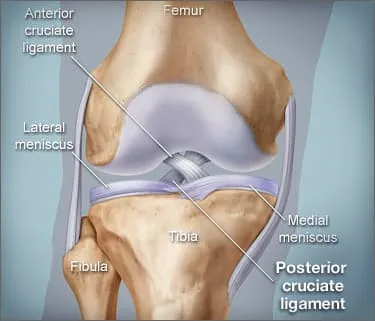

Medically Reviewed by Ross Brakeville, DPT on September 13, 2023
Written by Eric Metcalf, MPHThe posterior cruciate ligament (PCL) is a ligament within the knee. Ligaments are tough bands of tissue that connect bones.
The PCL -- similar to the anterior cruciate ligament (ACL) -- connects the thigh bone (femur) to your shin bone (tibia). Although it is larger and stronger than the ACL, the PCL can be torn.

PCL tears make up less than 20% of injuries to knee ligaments. Injuries that tear the PCL often damage some of the other ligaments or cartilage in the knee, as well. In some cases, the ligament can also break loose a piece of underlying bone.
PCL injuries are often due to a blow to the knee while it's bent.
There are a number of ways your PCL can be damaged:
Sports are a common cause of PCL injury. These injuries are especially common in:
An injury to the PCL can cause mild to severe damage. Doctors classify PCL injuries in these groups:
PCL problems can be acute or chronic. Acute PCL problems are due to a sudden injury. Chronic PCL problems involve an injury that develops over time.
Most people don't feel or hear a "popping" sensation in the knee after a PCL injury. This is more common with an injury to the ACL.
After a PCL injury, people often think they only have a minor knee problem. They may try to go on with their usual activities. However, symptoms that can develop include:
If you have mild damage to the PCL and no other parts of your knee, you may not notice pain, swelling, or other problems at first. These symptoms may appear over time.
Over time, a PCL tear can lead to osteoarthritis in the knee.
To diagnose a PCL injury, a doctor may take these steps:
History. Your doctor will ask what you were doing when the injury occurred, such as traveling in a car or playing a sport. They will also ask:
Physical examination. In a common test for PCL injuries, you lie on your back with your knee bent. Your doctor then examines your knee and presses against your upper shin. Abnormal knee movement during this test suggests a PCL injury.
One sign that the PCL is torn is that your knee may appear to droop backwards in a way that isn’t natural when your doctor straightens your leg.
You may also be checked with a device called an arthrometer. This presses against your leg to measure the ligament's tightness.
Your doctor may also ask you to walk. An abnormal walking motion may point to a PCL injury.
Imaging. X-rays can provide information about a PCL injury. They can detect pieces of bone that may have broken loose from the injury.
Magnetic resonance imaging (MRI) is a common way to create images of a PCL tear. An MRI can find the exact location of a tear.
With chronic PCL injuries, a bone scan may be needed to look for damage to the bones.
For the initial treatment of a PCL injury, the approach known as PRICE may be helpful. This includes:
You might also get some relief from over-the-counter pain relievers like aspirin, ibuprofen, or naproxen. They help to reduce pain and swelling.
You can recover from some posterior cruciate ligament injuries without surgery.
Cases that may not require surgery include:
Some people need to go through physical therapy after a PCL injury. Your physical therapist (PT) will give you specific exercises to do. They’ll help strengthen the leg muscles around your knee and bring a full range of motion back to your knee joint.
You may go to physical therapy a few times a week and do some of the exercises at home on off days. You may need to stick with it for up to 6 months to heal completely.
This rehabilitation may be necessary with or without surgery.
Rehabilitation may include:
Most people don’t need surgery to fix a torn PCL. But you might if other ligaments in your knee have also been injured. Your doctor can let you know if surgery would be right for you.
Patients who may be more likely to need surgery include those who have:
If a piece of bone is torn off, a surgeon may fasten the bone back into place using a screw.
When you need PCL surgery, your doctor won’t stitch up your torn PCL. This doesn’t heal well, and it may tear again. Instead, your doctor will remove the old, torn ligament and replace it with new tissue.
The ligament may be replaced with:
It’s an arthroscopic procedure. That means the surgeon inserts tools and a camera through small cuts around your knee. It’s quicker to heal and results in less scarring than other knee surgery.
If your injury is severe, your doctor may recommend open surgery. This requires a large incision in the knee.
After surgery, the length of time needed for rehabilitation can range from 26 to 52 weeks.